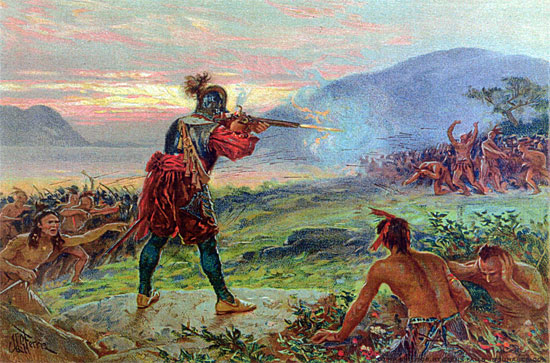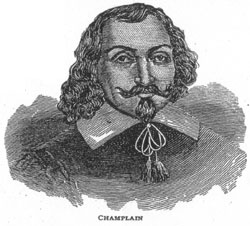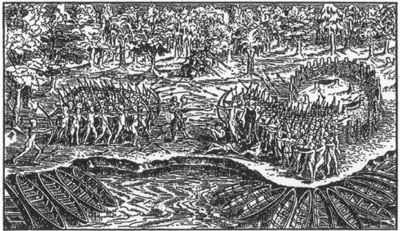| |

SAMUEL DE CHAMPLAIN was, from 1603 to 1635, the prominent figure and
leading spirit in French exploration and colonization in America..He was remarkable for intellectual and moral qualities; for his courageous and chivalrous exploits
and vastness of service.
In an early voyage to Mexico he visited Panama, and his journey reveals his, bold
conception of a ship canal across the isthmus, by which, he said, "the voyage to the
South Sea might be shortened by more than fifteen hundred leagues" – thus anticipating
this great project by quite three hundred years.
 He founded Quebec in 1608, and there learned from the Indians of a large lake to
the south, dotted with beautiful islands and surrounded by lofty mountains. He founded Quebec in 1608, and there learned from the Indians of a large lake to
the south, dotted with beautiful islands and surrounded by lofty mountains.
The region of this lake occupied a peculiar relation to the hostile Indians – the
Hurons, Algonquins and other tribes of the north, and their enemy, the mighty Iroquois,
or Five Nations, (afterwards the Six Nations) of the southwest. It was neutral ground,
mutual fear keeping it open and uninhabited; for it was the war path of the hostiles
each recurring summer.
About the middle of June, 1609, Champlain left for the exploration of
the heard of lake and with agreement with his Indian, allies to help him fight the Iroquois; they having great reliance upon the deadly efficiency of the arquebuses of the
French, the first firearms they had ever seen, and which they considered some necromancy of thunderbolts.
After delays, and considerable defection among his followers, he found himself early
in July above the Chambly Rapids of the then Richelieu River with only twenty-four
canoes, his servant, a French soldier and about sixty Indians; but, nothing daunted,
the intrepid Champlain continued and a couple of days later (perhaps and probably on
the Fourth of July) he entered "the mouth" of the beautiful lake which has preserved
his name to posterity.
Far fear of the Iroquois he cautiously proceeded by night along the west shore of the.
lake, having, as intimated by Parkman, the purpose of entering Lake George and proceeding
overland from its head to the "Great River" – the Hudson which a few weeks later
was discovered by Hendrick Hudson – at a point where Glens Falls now is, following that
river towards the sea, or make a foray into the Iroquois country along the Mohawk, and
thus extend the right of discovery under the French flag . Whatever has full purpose it was
defeated by the most important event of the expedition, except the discovery of the
lake.
In the dusk of the evening of July 29, a large fleet of canoes with about 200 Iroquois
warriors was discovered; near the promontory of Ticonderoga, approaching from the south.
Each party saw the other, and their defiant war-whoops appallingly mingled over the
waters and echoed through the forest.

Champlain's own sketch of his battle with the Iroquois. |
The Iroquois immediately landed and commenced felling trees for a barricade. By
some understanding battle was postponed till morning, Champlain and his allies remaining
in their canoes, lashed together with poles to prevent drifting apart, during the
night. The night was made hideous
with the shouting and war dances of
the savages. Champlain and his
French companions were kept hidden
by the wily Hurons from the sight of
the Iroquois.
Early next: morning the allies
landed unopposed, Champlain in the
rear, having sent his companions with
their arquebuses secretly to the
woods on the flank of
the enemy. The Iroquois, confident in
their superior numbers, came out from
their barricade and
Champlain beheld
with admiration the
steady approach of
the bravest and
fiercest warriors of
North America, led by
their plumed chiefs.
As they neared
each other, Champlain was loudly
called for with his
"hurler of thunder,"
and opening a way
for him to the front,
he advanced, as his
journal says, "about
twenty paces, until I
was about thirty paces from-the enemy," and there he deliberately stood revealed to
the astonished gaze of the Iroquois, who beheld with "mute amazement" this separated,
single, armored, war-like apparition with its mysterious arquebus.
"When I saw them preparing to shoot their arrows," quaintly says Champlain's
journal, "I raised my arquebus and aiming directly at one of the three chiefs, two of
them fell by this shot and one of his companions received a wound of which he after
wards died. I had put four balls in my arquebus. Ours on witnessing a shot so favorable
to them, set up such tremendous shouts that thunder could not be heard, and yet
there was no lack of arrow on one side or the other."
This scene is the subject of a painting by Mr. Ferris, owned by the Glens Falls
Insurance Company, excellently reproduced above. The dim break-of-day light with the summer morning mists and the pose of Champlain leaning forward to
resist the recoil of his heavy arquebus, etc., are artistically treated.
"As I was reloading," continues Champlain's journal, "one of my companions fired
a shot, which so astonished them anew, seeing their chiefs slain, that they lost courage,
took flight, hiding in the depth of the forest, whither pursuing them I killed some others.
Our savages also killed several of them and took ten or twelve prisoners. The rest carried
off the wounded. Fifteen or sixteen of ours were wounded; these were promptly
cured."
After the victory Champlain felt compelled to hastily return to Quebec, the prisoners
furnishing nightly sport for their savage captors in tortures too horrible for present
day thinking, and probably, in spite of Champlain's protestations.
Such was the discovery of Lake Champlain, the first use of firearms and the first
encounter of the Christian white man and pagan savage on the soil of New York, eleven
years before the landing of the Pilgrims; a thus did New France heedlessly rush into
conflict with the mighty warriors of the Five Nations and instigate that hatred of the
French which for more than a century wrought bloody havoc and horror throughout
Northern New York and Canada.
This battle, of so much historic interest in many ways, was, with little doubt, fought
at Ticonderoga; and may we not believe it providential, retributive or otherwise, that
this first wanton shedding of aboriginal blood by the Christian invader was on the soil
which was destined to afterwards witness the sanguinary though fruitless conflicts of the
mightiest powers in Christendom for the possession of the same territory, and which
neither of them was permitted permanently to enjoy?
Back to the Stories of the French & Indian and Revolutionary Wars. |


